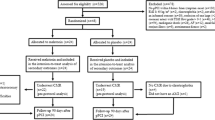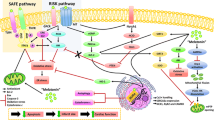Abstract
Acute coronary occlusion is effectively treated by primary percutaneous coronary intervention. However, myocardial ischemia–reperfusion injury is at the moment an unavoidable consequence of the procedure. Oxidative stress is central in the development of ischemia–reperfusion injury. Melatonin, an endogenous hormone, acts through antioxidant mechanisms and could potentially minimize the myocardial injury. The aim of the experimental study was to examine the cardioprotective effects of melatonin in a porcine closed-chest reperfused infarction model. A total of 20 landrace pigs were randomized to a dosage of 200 mg (0.4 mg/mL) melatonin or placebo (saline). The intervention was administered intracoronary and intravenous. Infarct size, area at risk and microvascular obstruction were determined ex vivo by cardiovascular magnetic resonance imaging. Myocardial salvage index was calculated. The plasma levels of high-sensitive troponin T were assessed repeatedly. The experimenters were blinded with regard to treatment regimen. Melatonin did not significantly increase myocardial salvage index compared with placebo [melatonin 21.8 % (16.1; 24.8) vs. placebo 20.2 % (16.9; 27.0), p = 1.00]. The extent of microvascular obstruction was similar between the groups [melatonin 3.8 % (2.7; 7.1) vs. placebo 3.7 % (1.3; 7.7), p = 0.96]. The area under the curve for high-sensitive troponin T release was insignificantly reduced by 32 % in the melatonin group [AUC melatonin 12,343.9 (6,889.2; 20,147.4) ng h/L vs. AUC placebo 18,285.3 (5,180.4; 23,716.8) ng h/L, p = 0.82]. Combined intracoronary and intravenous treatment with melatonin did not reduce myocardial reperfusion injury. The lack of a positive effect could be due to an ineffective dose of melatonin, a type II error or the timing of administration.



Similar content being viewed by others
References
(1997) A clinical trial comparing primary coronary angioplasty with tissue plasminogen activator for acute myocardial infarction. The global use of strategies to open occluded coronary arteries in acute coronary syndromes (GUSTO IIb). Angioplasty Substudy Investigators. N Engl J Med 336:1621–1628
Hausenloy DJ, Yellon DM (2008) Time to take myocardial reperfusion injury seriously. N Engl J Med 359:518–520
Yellon DM, Hausenloy DJ (2007) Myocardial reperfusion injury. N Engl J Med 357:1121–1135
Qin C, Yap S, Woodman OL (2009) Antioxidants in the prevention of myocardial ischemia/reperfusion injury. Expert Rev Clin Pharmacol 2:673–695
Roberts MJ, Young IS, Trimble ER, Khan MM, Webb SW, Wilson CM, Patterson GC, Adgey AA (1990) Transient release of lipid peroxides after coronary artery balloon angioplasty. Lancet 336:143–145
Zweier JL, Kuppusamy P, Williams R, Rayburn BK, Weisfeldt ML, Flaherty JT (1989) Measurement and characterization of postischemic free radical generation in the isolated perfused heart. J Biol Chem 264:18890–18895
Guan W, Osanai T, Kamada T, Hanada H, Ishizaka H, Onodera H, Iwasa A, Fujita N, Kudo S, Ohkubo T, Okumura K (2003) Effect of allopurinol pretreatment on free radical generation after primary coronary angioplasty for acute myocardial infarction. J Cardiovasc Pharmacol 41:699–705
Perrelli MG, Pagliaro P, Penna C (2011) Ischemia/reperfusion injury and cardioprotective mechanisms: role of mitochondria and reactive oxygen species. World J Cardiol 3:186–200
Os Ali, Abdelgawad HM, Mohammed MS, El-Awady RR (2013) Ischemic heart diseases in Egypt: role of xanthine oxidase system and ischemia-modified albumin. Heart Vessels. doi:10.1007/s00380-013-0413-3
Zhao Q, Hu X, Shao L, Wu G, Du J, Xia J (2013) LipoxinA4 attenuates myocardial ischemia reperfusion injury via a mechanism related to downregulation of GRP-78 and caspase-12 in rats. Heart Vessels. doi:10.1007/s00380-013-0418-y
Sugamura K, Keaney JF (2011) Reactive oxygen species in cardiovascular disease. Free Radic Biol Med 51:978–992
Kutala VK, Khan M, Angelos MG, Kuppusamy P (2007) Role of oxygen in postischemic myocardial injury. Antioxid Redox Signal 9:1193–1206
Reiter RJ, Tan DX, Gitto E, Sainz RM, Mayo JC, Leon J, Manchester LC, Vijayalaxmi Kilic E, Kilic U (2004) Pharmacological utility of melatonin in reducing oxidative cellular and molecular damage. Pol J Pharmacol 56:159–170
Sahna E, Olmez E, Acet A (2002) Effects of physiological and pharmacological concentrations of melatonin on ischemia–reperfusion arrhythmias in rats: can the incidence of sudden cardiac death be reduced? J Pineal Res 32:194–198
Kaneko S, Okumura K, Numaguchi Y, Matsui H, Murase K, Mokuno S, Morishima I, Hira K, Toki Y, Ito T, Hayakawa T (2000) Melatonin scavenges hydroxyl radical and protects isolated rat hearts from ischemic reperfusion injury. Life Sci 67:101–112
Galano A, Tan DX, Reiter RJ (2011) Melatonin as a natural ally against oxidative stress: a physicochemical examination. J Pineal Res 51:1–16
Allegra M, Reiter RJ, Tan DX, Gentile C, Tesoriere L, Livrea MA (2003) The chemistry of melatonin’s interaction with reactive species. J Pineal Res 34:1–10
Tan DX, Manchester LC, Terron MP, Flores LJ, Reiter RJ (2007) One molecule, many derivatives: a never-ending interaction of melatonin with reactive oxygen and nitrogen species? J Pineal Res 42:28–42
De Almeida EA, Martinez GR, Klitzke CF, de Medeiros MH, Di Mascio P (2003) Oxidation of melatonin by singlet molecular oxygen (O2(1deltag)) produces N1-acetyl-N2-formyl-5-methoxykynurenine. J Pineal Res 35:131–137
Tan DX, Reiter RJ, Manchester LC, Yan MT, El-Sawi M, Sainz RM, Mayo JC, Kohen R, Allegra M, Hardeland R (2002) Chemical and physical properties and potential mechanisms: melatonin as a broad spectrum antioxidant and free radical scavenger. Curr Top Med Chem 2:181–197
Rodriguez C, Mayo JC, Sainz RM, Antolín I, Herrera F, Martín V, Reiter RJ (2004) Regulation of antioxidant enzymes: a significant role for melatonin. J Pineal Res 36:1–9
Gitto E, Tan DX, Reiter RJ, Karbownik M, Manchester LC, Cuzzocrea S, Fulia F, Barberi I (2001) Individual and synergistic antioxidative actions of melatonin: studies with vitamin E, vitamin C, glutathione and desferrioxamine (desferoxamine) in rat liver homogenates. J Pharm Pharmacol 53:1393–1401
Acuña-Castroviejo D, Martín M, Macías M, Escames G, León J, Khaldy H, Reiter RJ (2001) Melatonin, mitochondria, and cellular bioenergetics. J Pineal Res 30:65–74
Petrosillo G, Colantuono G, Moro N, Ruggiero FM, Tiravanti E, Di Venosa N, Fiore T, Paradies G (2009) Melatonin protects against heart ischemia–reperfusion injury by inhibiting mitochondrial permeability transition pore opening. Am J Physiol Heart Circ Physiol 297:H1487–H1493
Petrosillo G, Moro N, Ruggiero FM, Paradies G (2009) Melatonin inhibits cardiolipin peroxidation in mitochondria and prevents the mitochondrial permeability transition and cytochrome c release. Free Radic Biol Med 47:969–974
Lee YM, Chen HR, Hsiao G, Sheu JR, Wang JJ, Yen MH (2002) Protective effects of melatonin on myocardial ischemia/reperfusion injury in vivo. J Pineal Res 33:72–80
Szárszoi O, Asemu G, Vanecek J, Ost’ádal B, Kolár F (2001) Effects of melatonin on ischemia and reperfusion injury of the rat heart. Cardiovasc Drugs Ther 15:251–257
Lagneux C, Joyeux M, Demenge P, Ribuot C, Godin-Ribuot D (2000) Protective effects of melatonin against ischemia–reperfusion injury in the isolated rat heart. Life Sci 66:503–509
Tan DX, Manchester LC, Reiter RJ, Qi W, Kim SJ, El-Sokkary GH (1998) Ischemia/reperfusion-induced arrhythmias in the isolated rat heart: prevention by melatonin. J Pineal Res 25:184–191
Halladin NL, Ekeløf S, Jensen SE, Aarøe J, Kjærgaard B, Heegaard PM, Lykkesfeldt J, Rosenberg J, Gögenur I (2014) Melatonin does not affect oxidative/inflammatory biomarkers in a closed-chest porcine model of acute myocardial infarction. In Vivo 28:483–488
Gögenur I, Kücükakin B, Panduro Jensen L, Reiter RJ, Rosenberg J (2014) Melatonin reduces cardiac morbidity and markers of myocardial ischemia after elective abdominal aortic aneurism repair: a randomized, placebo-controlled, clinical trial. J Pineal Res. doi:10.1111/jpi.12138
Kim RJ, Fieno DS, Parrish TB, Harris K, Chen EL, Simonetti O, Bundy J, Finn JP, Klocke FJ, Judd RM (1999) Relationship of MRI delayed contrast enhancement to irreversible injury, infarct age, and contractile function. Circulation 100:1992–2002
Van der Pals J, Koul S, Andersson P, Götberg M, Ubachs JF, Kanski M, Arheden H, Olivecrona GK, Larsson B, Erlinge D (2010) Treatment with the C5a receptor antagonist ADC-1004 reduces myocardial infarction in a porcine ischemia–reperfusion model. BMC Cardiovasc Disord 10:45
Ubachs JF, Engblom H, Koul S, Kanski M, Andersson P, van der Pals J, Carlsson M, Erlinge D, Arheden H (2013) Myocardium at risk can be determined by ex vivo T2-weighted magnetic resonance imaging even in the presence of gadolinium: comparison to myocardial perfusion single photon emission computed tomography. Eur Heart J Cardiovasc Imaging 14:261–268
Arai AE (2011) Magnetic resonance imaging for area at risk, myocardial infarction, and myocardial salvage. J Cardiovasc Pharmacol Ther 16:313–320
Sahna E, Parlakpinar H, Turkoz Y, Acet A (2005) Protective effects of melatonin on myocardial ischemia/reperfusion induced infarct size and oxidative changes. Physiol Res 54:491–495
Chen Z, Chua CC, Gao J, Hamdy RC, Chua BH (2003) Protective effect of melatonin on myocardial infarction. Am J Physiol Heart Circ Physiol 284:H1618–H1624
Zweier JL, Flaherty JT, Weisfeldt ML (1987) Direct measurement of free radical generation following reperfusion of ischemic myocardium. Proc Natl Acad Sci USA 84:1404–1407
Pérez de Prado A, Cuellas-Ramón C, Regueiro-Purriños M, Gonzalo-Orden JM, Pérez-Martínez C, Altónaga JR, García-Iglesias MJ, Orden-Recio MA, García Marín JF, Fernández-Vázquez F (2009) Closed-chest experimental porcine model of acute myocardial infarction–reperfusion. J Pharmacol Toxicol Methods 60:301–306
Suzuki Y, Lyons JK, Yeung AC, Ikeno F (2008) In vivo porcine model of reperfused myocardial infarction: in situ double staining to measure precise infarct area/area at risk. Catheter Cardiovasc Interv 71:100–107
Krombach GA, Kinzel S, Mahnken AH, Buecker A (2005) Minimally invasive close-chest method for creating reperfused or occlusive myocardial infarction in swine. Invest Radiol 40:14–18
Busch SV, Halladin NL, Jensen SE, Rosenberg J, Gögenur I (2012) Closed-chest porcine model is superior in intervention studies of ischaemia reperfusion injury. Ugeskr Laeger 174:1807–1810
Thiele H, Hildebrand L, Schirdewahn C, Eitel I, Adams V, Fuernau G, Erbs S, Linke A, Diederich KW, Nowak M, Desch S, Gutberlet M, Schuler G (2010) Impact of high-dose N-acetylcysteine versus placebo on contrast-induced nephropathy and myocardial reperfusion injury in unselected patients with ST-segment elevation myocardial infarction undergoing primary percutaneous coronary intervention. The LIPSIA-N-ACC (Prospective, Single-Blind, Placebo-Controlled, Randomized Leipzig Immediate PercutaneouS Coronary Intervention Acute Myocardial Infarction N-ACC) trial. J Am Coll Cardiol 55:2201–2209
Chan W, Taylor AJ, Ellims AH, Lefkovits L, Wong C, Kingwell BA, Natoli A, Croft KD, Mori T, Kaye DM, Dart AM, Duffy SJ (2012) Effect of iron chelation on myocardial infarct size and oxidative stress in ST-elevation-myocardial infarction. Circ Cardiovasc Interv 5:270–278
Lønborg J, Kelbæk H, Vejlstrup N, Bøtker HE, Kim WY, Holmvang L, Jørgensen E, Helqvist S, Saunamäki K, Terkelsen CJ, Schoos MM, Køber L, Clemmensen P, Treiman M, Engstrøm T (2012) Exenatide reduces final infarct size in patients with ST-segment-elevation myocardial infarction and short-duration of ischemia. Circ Cardiovasc Interv 5:288–295
Maruhashi T, Ishihara M, Inoue I, Kawagoe T, Shimatani Y, Kurisu S, Nakama Y, Kagawa E, Dai K, Matsushita J, Ikenaga H (2010) Effect of prodromal angina pectoris on the infarct progression in patients with first ST-elevation acute myocardial infarction. Circ J 74:1651–1657
Dominguez-Rodriguez A, Abreu-Gonzalez P, Garcia-Gonzalez MJ, Kaski JC, Reiter RJ, Jimenez-Sosa A (2007) A unicenter, randomized, double-blind, parallel-group, placebo-controlled study of Melatonin as an Adjunct in patients with acute myocaRdial Infarction undergoing primary Angioplasty The Melatonin Adjunct in the acute myocaRdial Infarction treated with Angioplasty (MARIA) trial: study design and rationale. Contemp Clin Trials 28:532–539
Halladin NL, Busch SE, Jensen SE, Hansen HS, Zaremba T, Aarøe J, Rosenberg J, Gögenur I (2014) Intracoronary and systemic melatonin to patients with acute myocardial infarction: protocol for the IMPACT trial. Dan Med J 61:A4773
Acknowledgments
A special thanks to the Department of Diagnostic Imaging, the Laboratory of Biomedical Science and the staff at the Department of Cardiology, Aalborg University Hospital, Denmark. This work was supported by grants from the Lundbeck Foundation, the Aase and Ejnar Danielsens Foundation, the A. P. Møller Foundation for the Advancement of Medical Science, the Axel Muusfeldts Foundation, the Arvid Nilssons Foundation and the Snedkermester Sophus Jacobsens Foundation. These funders have had no influence on the study design, data collection, analysis and interpretation of data, or writing of the manuscript.
Conflict of interest
The authors declare that they have no conflict of interest.
Author information
Authors and Affiliations
Corresponding author
Rights and permissions
About this article
Cite this article
Ekeløf, S.V., Halladin, N.L., Jensen, S.E. et al. Effects of intracoronary melatonin on ischemia–reperfusion injury in ST-elevation myocardial infarction. Heart Vessels 31, 88–95 (2016). https://doi.org/10.1007/s00380-014-0589-1
Received:
Accepted:
Published:
Issue Date:
DOI: https://doi.org/10.1007/s00380-014-0589-1




